2014 MITSUBISHI LANCER SPORTBACK lock
[x] Cancel search: lockPage 40 of 422
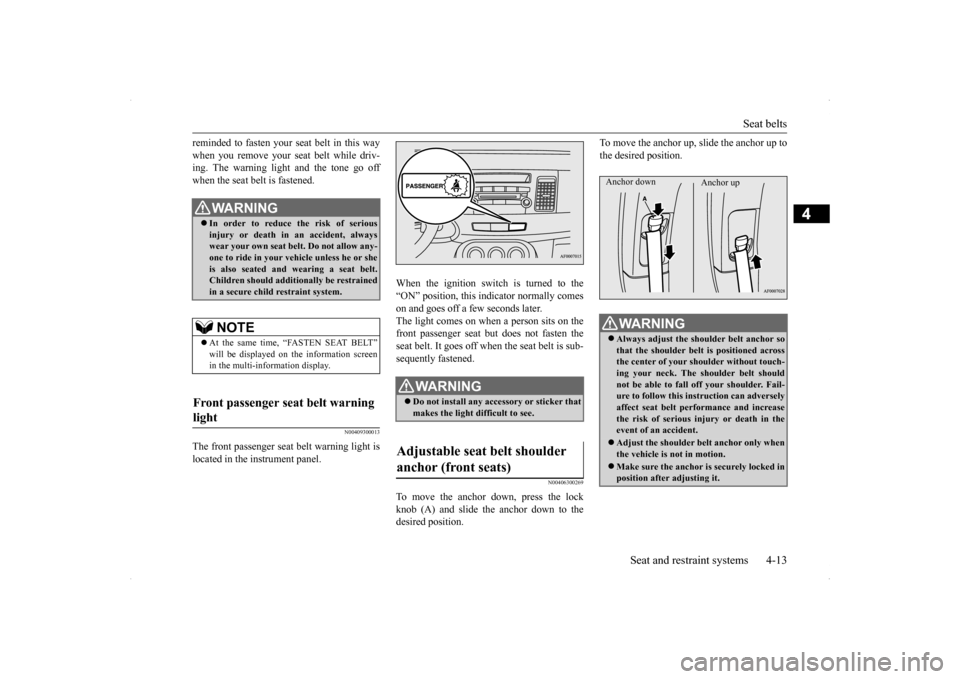
Seat belts
Seat and restraint systems 4-13
4
reminded to fasten your seat belt in this way when you remove your seat belt while driv- ing. The warning light and the tone go off when the seat belt is fastened.
N00409300013
The front passenger seat belt warning light islocated in the instrument panel.
When the ignition switch is turned to the “ON” position, this indicator normally comeson and goes off a few seconds later. The light comes on when a person sits on the front passenger seat but does not fasten theseat belt. It goes off when the seat belt is sub- sequently fastened.
N00406300269
To move the anchor down, press the lock knob (A) and slide the anchor down to the desired position.
To move the anchor up, slide the anchor up to the desired position.
WA R N I N G In order to reduce the risk of serious injury or death in an accident, alwayswear your own seat belt. Do not allow any- one to ride in your vehicle unless he or she is also seated and wearing a seat belt.Children should additionally be restrained in a secure child restraint system.NOTE
At the same time, “FASTEN SEAT BELT” will be displayed on the information screen in the multi-information display.
Front passenger seat belt warning light
WA R N I N G Do not install any accessory or sticker that makes the light difficult to see.
Adjustable seat belt shoulder anchor (front seats)
WA R N I N G Always adjust the shoulder belt anchor so that the shoulder belt is positioned acrossthe center of your shoulder without touch- ing your neck. The shoulder belt should not be able to fall off your shoulder. Fail-ure to follow this instruction can adversely affect seat belt performance and increase the risk of serious injury or death in theevent of an accident. Adjust the shoulder belt anchor only when the vehicle is not in motion. Make sure the anchor is securely locked in position after adjusting it.Anchor down
Anchor up
BK0200700US.bo
ok 13 ページ 2013年2月15日 金曜日 午後12時17分
Page 47 of 422
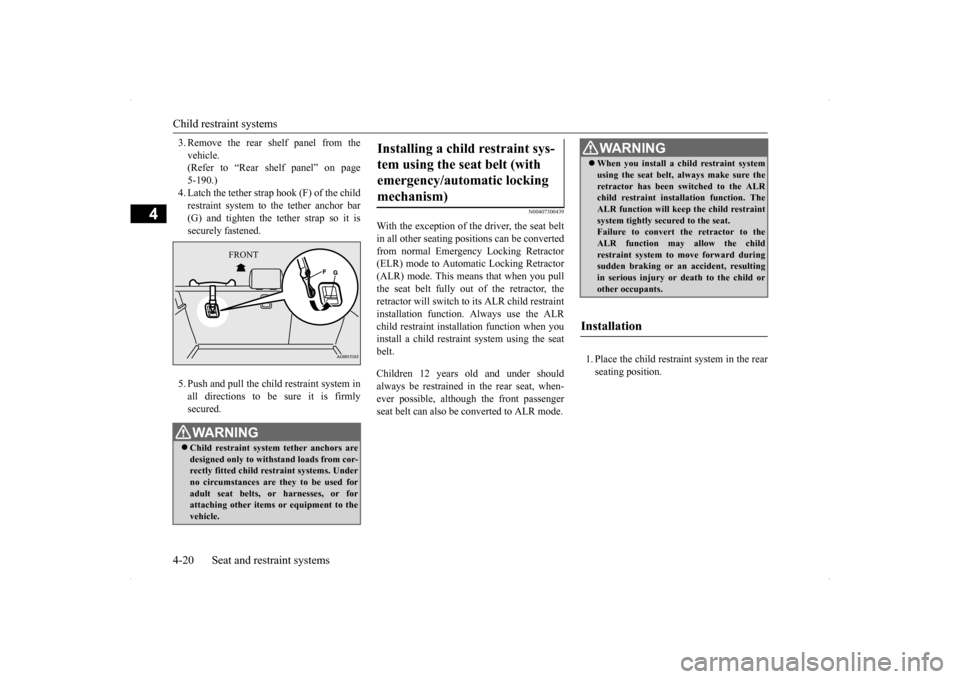
Child restraint systems 4-20 Seat and restraint systems
4
3. Remove the rear shelf panel from the vehicle. (Refer to “Rear shelf panel” on page 5-190.)4. Latch the tether strap hook (F) of the child restraint system to the tether anchor bar (G) and tighten the tether strap so it issecurely fastened. 5. Push and pull the child restraint system in all directions to be sure it is firmlysecured.
N00407300439
With the exception of the driver, the seat beltin all other seating positions can be convertedfrom normal Emergency Locking Retractor (ELR) mode to Automatic Locking Retractor (ALR) mode. This means that when you pullthe seat belt fully out of the retractor, theretractor will switch to its ALR child restraint installation function. Always use the ALR child restraint installation function when youinstall a child restraint system using the seat belt. Children 12 years old and under should always be restrained in the rear seat, when-ever possible, although the front passenger seat belt can also be converted to ALR mode.
1. Place the child restraint system in the rear seating position.
WA R N I N G Child restraint system tether anchors are designed only to withstand loads from cor- rectly fitted child restraint systems. Underno circumstances are they to be used for adult seat belts, or harnesses, or for attaching other items or equipment to thevehicle.
FRONT
Installing a child restraint sys- tem using the seat belt (with emergency/automatic locking mechanism)
WA R N I N G When you install a child restraint system using the seat belt, always make sure the retractor has been switched to the ALR child restraint installation function. The ALR function will keep the child restraintsystem tightly secured to the seat. Failure to convert the retractor to the ALR function may allow the childrestraint system to move forward during sudden braking or an accident, resulting in serious injury or death to the child orother occupants.
Installation
BK0200700US.bo
ok 20 ページ 2013年2月15日 金曜日 午後12時17分
Page 48 of 422
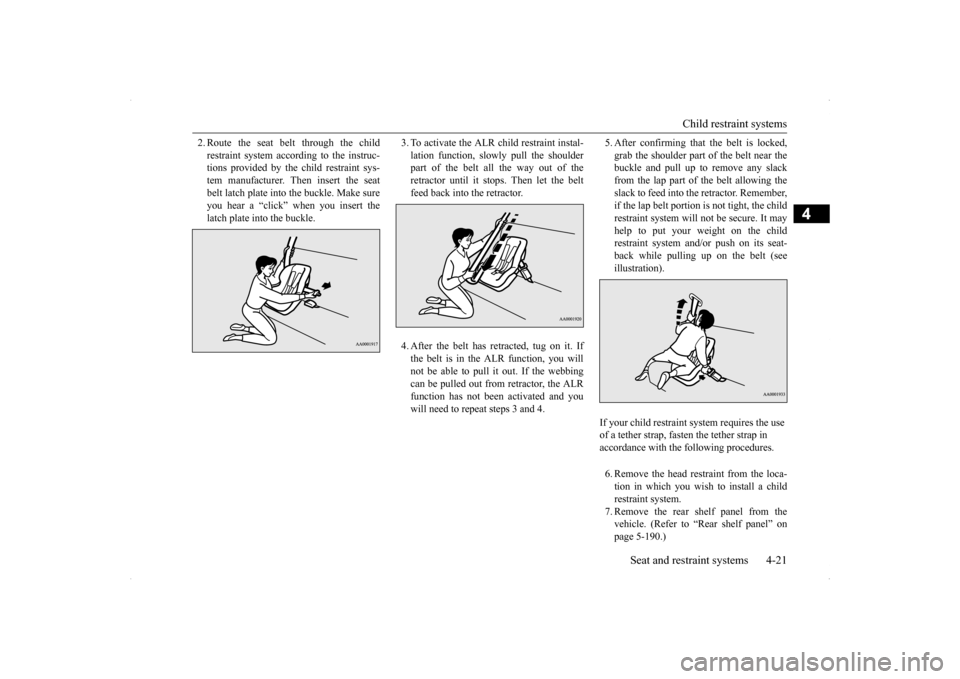
Child restraint systems
Seat and restraint systems 4-21
4
2. Route the seat belt through the child restraint system according to the instruc- tions provided by the child restraint sys- tem manufacturer. Then insert the seatbelt latch plate into the buckle. Make sure you hear a “click” when you insert the latch plate into the buckle.
3. To activate the ALR child restraint instal- lation function, slowly pull the shoulder part of the belt all the way out of the retractor until it stops. Then let the beltfeed back into the retractor. 4. After the belt has retracted, tug on it. If the belt is in the ALR function, you willnot be able to pull it out. If the webbing can be pulled out from retractor, the ALR function has not been activated and youwill need to repeat steps 3 and 4.
5. After confirming that the belt is locked, grab the shoulder part of the belt near the buckle and pull up to remove any slack from the lap part of the belt allowing theslack to feed into the retractor. Remember, if the lap belt portion is not tight, the child restraint system will not be secure. It mayhelp to put your weight on the child restraint system and/or push on its seat- back while pulling up on the belt (seeillustration). 6. Remove the head restraint from the loca- tion in which you wish to install a child restraint system.7. Remove the rear shelf panel from the vehicle. (Refer to “Rear shelf panel” on page 5-190.)
If your child restraint system requires the use of a tether strap, fasten the tether strap in accordance with the following procedures.
BK0200700US.bo
ok 21 ページ 2013年2月15日 金曜日 午後12時17分
Page 49 of 422
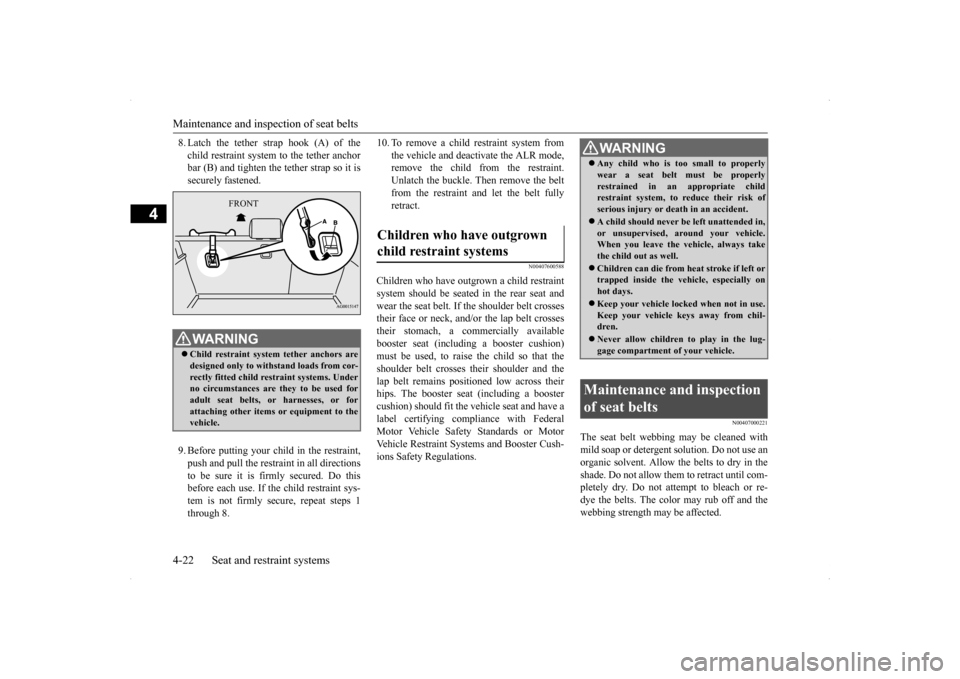
Maintenance and inspection of seat belts 4-22 Seat and restraint systems
4
8. Latch the tether strap hook (A) of the child restraint system to the tether anchor bar (B) and tighten the tether strap so it is securely fastened. 9. Before putting your child in the restraint, push and pull the restraint in all directionsto be sure it is firmly secured. Do this before each use. If the child restraint sys- tem is not firmly secure, repeat steps 1through 8.
10. To remove a child restraint system from
the vehicle and deactivate the ALR mode, remove the child from the restraint. Unlatch the buckle. Then remove the beltfrom the restraint and let the belt fully retract.
N00407600588
Children who have outgrown a child restraintsystem should be seated in the rear seat and wear the seat belt. If the shoulder belt crossestheir face or neck, and/or the lap belt crosses their stomach, a commercially available booster seat (including a booster cushion)must be used, to raise the child so that the shoulder belt crosses their shoulder and the lap belt remains positioned low across theirhips. The booster seat (including a booster cushion) should fit the vehicle seat and have a label certifying compliance with FederalMotor Vehicle Safety Standards or Motor Vehicle Restraint Systems and Booster Cush- ions Safety Regulations.
N00407000221
The seat belt webbing may be cleaned withmild soap or detergent solution. Do not use anorganic solvent. Allow the belts to dry in the shade. Do not allow them to retract until com- pletely dry. Do not attempt to bleach or re-dye the belts. The color may rub off and the webbing strength may be affected.
WA R N I N G Child restraint system tether anchors are designed only to withstand loads from cor- rectly fitted child restraint systems. Under no circumstances are they to be used foradult seat belts, or harnesses, or for attaching other items or equipment to the vehicle.
FRONT
Children who have outgrown child restraint systems
WA R N I N G Any child who is too small to properly wear a seat belt must be properly restrained in an appropriate child restraint system, to reduce their risk of serious injury or death in an accident. A child should never be left unattended in, or unsupervised, around your vehicle.When you leave the vehicle, always take the child out as well. Children can die from heat stroke if left or trapped inside the vehicle, especially on hot days. Keep your vehicle locked when not in use. Keep your vehicle keys away from chil-dren. Never allow children to play in the lug- gage compartment of your vehicle.
Maintenance and inspection of seat belts
BK0200700US.bo
ok 22 ページ 2013年2月15日 金曜日 午後12時17分
Page 50 of 422

Supplemental Restraint System (SRS) - airbag
Seat and restraint systems 4-23
4
Regularly check your seat belt buckles and their release mechanisms for positive engage- ment and release of the latch plate. Check the retractors for automatic locking when in theAutomatic Locking Retractor function. The entire seat belt assembly should be replaced if the webbing shows any obvious cuts, tears, increase in thickness in any sec-tion of the webbing from broken fibers, or severe fading from sunlight. All of these con- ditions indicate a weakening of the belt,which may adversely affect seat belt perfor-mance in an accident.
N00407701733
This vehicle is equipped with a SupplementalRestraint System (SRS), which includes air-bags for the driver and passengers.
The SRS front airbags are designed to supple- ment the primary protection of the driver and front passenger seat belt systems by provid- ing those occupants with protection againsthead and chest injuries in certain moderate to severe frontal collisions. The SRS front airbags, together with sensorsat the front of the vehicle and sensors attached to the front seats, form an advanced airbag system. The SRS driver’s knee airbag is designed to supplement the primary protection of thedriver’s seat belt system. It can reduce the forward movement of the driver’s lower legs and provide increased overall body protectionin certain moderate to severe frontal colli- sions. The SRS side airbags and the curtain airbags are also designed to supplement the seat belts.The SRS side airbags provide the driver and front passenger with protection against chest injuries by deploying the bag on the sideimpacted in moderate to severe side impact collisions. The SRS curtain airbags provide the driver and passengers on the front seatand rear outboard seat with protection against head injuries by deploying a bag on the side impacted in moderate to severe side impactcollisions.
The SRS airbags are NOT
a substitute for use
of the seat belts. For maximum protection in all types of accidents, seat belts must ALWAYS be worn by everyone who drives orrides in this vehicle (with infants and small children in an appropriate child restraint sys- tem in the rear seat, and older children buck-led in the rear seat). Refer to “Child restraint systems” on page 4-15.
WA R N I N G Do not attempt to repair or replace any part of the seat belt assemblies. This work should be done by an authorized Mitsubishi Motors dealer. Failure to havean authorized Mitsubishi Motors dealer perform the work could reduce the effec- tiveness of the belts and could result in aserious injury or death in an accident.
Supplemental Restraint Sys- tem (SRS) - airbag
WA R N I N G IT IS VERY IMPORTANT TO ALWAYS WEAR YOUR SEAT BELT PROPERLY EVEN WITH AN AIRBAG.• Seat belts help keep the driver and pas-sengers properly positioned. This reduces the risk of injury in all collisions,and reduces the risk of serious injuries or death when the airbags inflate. During sudden braking just before a col-lision, an unrestrained or improperly restrained driver or passengers can move forward into direct contact with, orwithin close proximity to, the airbag when it begins to inflate. The beginning stage of airbag inflation isthe most forceful and can cause serious injuries or death if the occupant comes in contact with the airbag at this time. • Seat belts reduce the risk of injury inrollovers, rear impact collisions, and in lower-speed frontal collisions, because the airbags are not designed to inflate inthose situations.
BK0200700US.bo
ok 23 ページ 2013年2月15日 金曜日 午後12時17分
Page 68 of 422
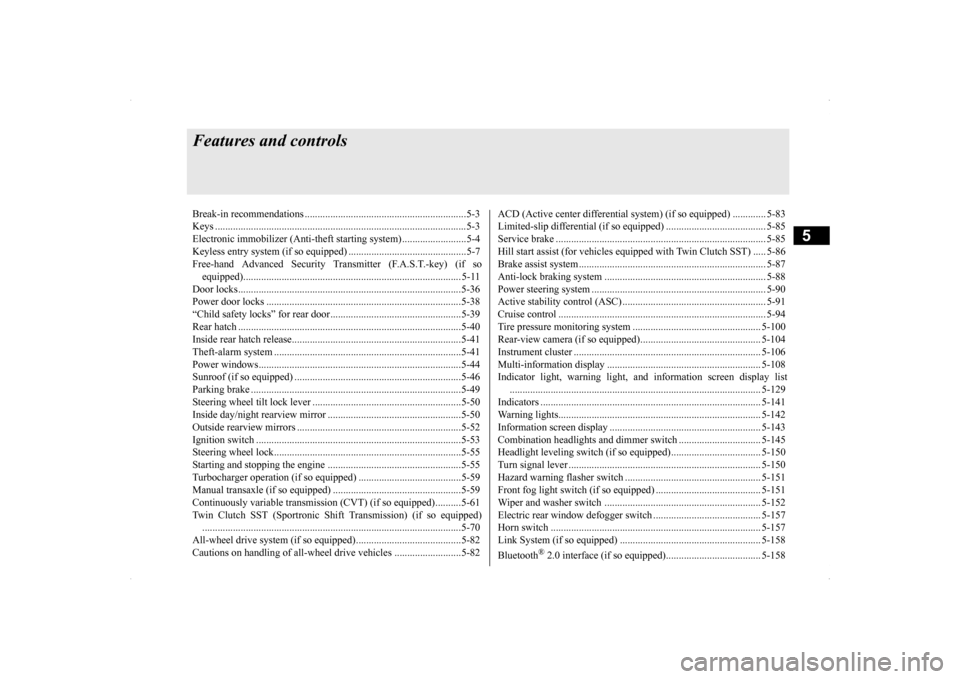
5
Features and controlsBreak-in recommendation
s ...............................................................5-3
Keys .....................................................
.............................................5-3
Electronic immobilizer (Anti-theft starting system) .........................5-4 Keyless entry system (if so equipped) ..............................................5-7Free-hand Advanced Security Transmitter (F.A.S.T.-key) (if so equipped)................................
..................................................... 5-11
Door locks........................
...............................................................5-36
Power door locks .............
...............................................................5-38
“Child safety locks” for
rear door...................................................5-39
Rear hatch ........................
...............................................................5-40
Inside rear hatch rel
ease................................
..................................5-41
Theft-alarm system ..........
...............................................................5-41
Power windows................
...............................................................5-44
Sunroof (if so equipped
) .........................................
........................5-46
Parking brake ...................
...............................................................5-49
Steering wheel tilt lock lever ..........................................................5-50Inside day/night rearview
mirror ....................................................5-50
Outside rearview mirr
ors ................................................................5-52
Ignition switch .................
...............................................................5-53
Steering wheel lock..........
...............................................................5-55
Starting and stopping the e
ngine ....................................................5-55
Turbocharger operation (if so equipped) ........................................5-59Manual transaxle (if so equipped) ..................................................5-59Continuously variable transmissi
on (CVT) (if so equipped)..........5-61
Twin Clutch SST (Sportronic Shif
t Transmission) (if so equipped)
...................................................................
..................................5-70
All-wheel drive system (if
so equipped).........................................5-82
Cautions on handling of all-wheel drive vehicles ..........................5-82
ACD (Active center differential system) (if so equipped) ............. 5-83 Limited-slip differential (i
f so equipped) ....................................... 5-85
Service brake ..................
.................................................
............... 5-85
Hill start assist (for vehicles equipped with Twin Clutch SST) ..... 5-86Brake assist system
................................................
......................... 5-87
Anti-lock braking syst
em ......................................
......................... 5-88
Power steering system
...........................................
......................... 5-90
Active stability control
(ASC) .....................
................................... 5-91
Cruise control .................
.................................................
............... 5-94
Tire pressure monitoring
system .................................................. 5-100
Rear-view camera (if so
equipped)..............
................................. 5-104
Instrument cluster .
.................................................
....................... 5-106
Multi-information disp
lay .....................................
....................... 5-108
Indicator light, warning light, and information screen display list
.................................................................
................................. 5-129
Indicators ..................................
.................................................... 5-141
Warning lights.................
.................................................
............. 5-142
Information screen disp
lay ....................................
....................... 5-143
Combination headlights and dimmer switch ................................ 5-145Headlight leveling switch (if
so equipped)................................... 5-150
Turn signal lever ...
.................................................
....................... 5-150
Hazard warning flasher
switch ..................................................... 5-151
Front fog light switch (if so
equipped) ......................................... 5-151
Wiper and washer swit
ch ......................................
....................... 5-152
Electric rear window def
ogger switch .......................................... 5-157
Horn switch ..............................
.................................................... 5-157
Link System (if so equi
pped) ....................................................... 5-158
Bluetooth
® 2.0 interface (if so
equipped)..................................... 5-158
BK0200700US.bo
ok 1 ページ 2013年2月15日 金曜日 午後12時17分
Page 70 of 422
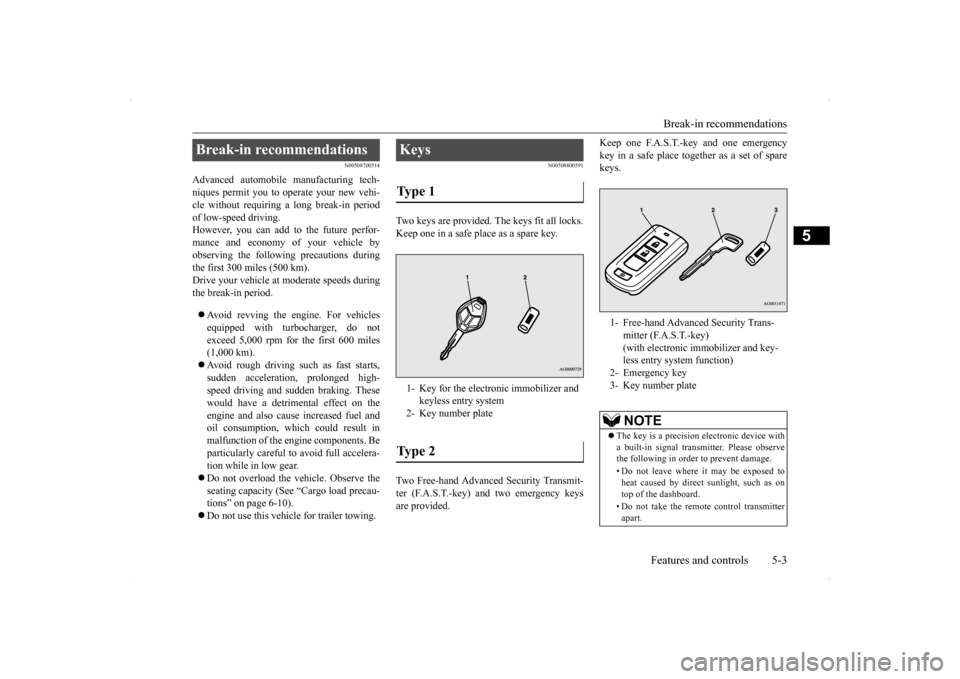
Break-in recommendations
Features and controls 5-3
5
N00508700314
Advanced automobile manufacturing tech- niques permit you to operate your new vehi-cle without requiring a long break-in period of low-speed driving. However, you can add to the future perfor-mance and economy of your vehicle by observing the following precautions during the first 300 miles (500 km).Drive your vehicle at moderate speeds duringthe break-in period. Avoid revving the engine. For vehicles equipped with turbocharger, do not exceed 5,000 rpm for the first 600 miles(1,000 km). Avoid rough driving such as fast starts, sudden acceleration, prolonged high-speed driving and sudden braking. These would have a detrimental effect on the engine and also cause increased fuel andoil consumption, which could result in malfunction of the engine components. Be particularly careful to avoid full accelera-tion while in low gear. Do not overload the vehicle. Observe the seating capacity (See “Cargo load precau-tions” on page 6-10). Do not use this vehicle for trailer towing.
N00508800591
Two keys are provided. The keys fit all locks. Keep one in a safe place as a spare key. Two Free-hand Advanced Security Transmit- ter (F.A.S.T.-key) and two emergency keys are provided.
Keep one F.A.S.T.-key and one emergency key in a safe place together as a set of spare keys.
Break-in recommendations
Keys Type 1 1- Key for the electronic immobilizer and
keyless entry system
2- Key number plateType 2
1- Free-hand Advanced Security Trans-
mitter (F.A.S.T.-key) (with electronic immobilizer and key-less entry system function)
2- Emergency key 3- Key number plate
NOTE
The key is a precision electronic device with a built-in signal transmitter. Please observe the following in order to prevent damage. • Do not leave where it may be exposed to heat caused by direct sunlight, such as ontop of the dashboard. • Do not take the remote control transmitter apart.
BK0200700US.bo
ok 3 ページ 2013年2月15日 金曜日 午後12時17分
Page 71 of 422
![MITSUBISHI LANCER SPORTBACK 2014 8.G Owners Manual Electronic immobilizer (Anti-theft starting system) 5-4 Features and controls
5
N00509101817
[For vehicles equipped with the Free-hand Advanced Security Transmitter (F.A.S.T.- key)] For information on MITSUBISHI LANCER SPORTBACK 2014 8.G Owners Manual Electronic immobilizer (Anti-theft starting system) 5-4 Features and controls
5
N00509101817
[For vehicles equipped with the Free-hand Advanced Security Transmitter (F.A.S.T.- key)] For information on](/manual-img/19/7508/w960_7508-70.png)
Electronic immobilizer (Anti-theft starting system) 5-4 Features and controls
5
N00509101817
[For vehicles equipped with the Free-hand Advanced Security Transmitter (F.A.S.T.- key)] For information on operations for vehiclesequipped with the Free-hand Advanced Secu- rity Transmitter (F.A.S.T.-key), refer to “Free-hand Advanced Security Transmitter(F.A.S.T.-key): Electronic immobilizer (Anti- theft starting system)” on page 5-28.
[Except for vehicles equipped with the Free- hand Advanced Security Transmitter (F.A.S.T.-key)] The electronic immobilizer is designed to sig-nificantly reduce the possibility of vehicle theft. The purpose of the system is to immo- bilize the vehicle if an invalid start isattempted. A valid start attempt can only be achieved (subject to certain conditions) using a key “registered” to the immobilizer system.All of the keys provided with your new vehi-cle have been programmed to the vehicle’s electronics.
• Do not excessively bend the key or subject it to strong impacts. • Keep the remote control transmitter dry. • Keep away from magnetic objects such as key rings. • Keep away from devices that produce mag- netism, such as audio systems, computers and televisions. • Keep away from devices that emit strong electromagnetic waves, such as cellularphones, wireless devices and high fre- quency equipment (including medical devices.) • Do not clean with ultrasonic cleaners. • Do not leave the key where it may be exposed to high temperature or high humid- ity.
If you lose your key, to prevent the theft of the vehicle immediately contact an autho-rized Mitsubishi Motors dealer. If you notify an authorized Mitsubishi Motors dealer of the key number, they canmake a new key. The key number is stamped on the key number plate. Keep the key num- ber plate in a safe place separate from thekey itself.NOTE
No keys other than those registered in advance can be used to start the engine. Refer to “Electronic immobilizer (Anti-theft starting system)” on page 5-4. Refer to “Free-hand Advanced SecurityTransmitter (F.A.S.T.-key): Electronic immobilizer (Anti-theft starting system)” on page 5-28. When the theft-alarm is in the system opera- tional status, the alarm operates if a door orrear hatch is opened after using the key, the door lock knob or the power door lock to unlock the vehicle. The system does not enter the preparation status if the keyless entry system or theF.A.S.T.-key was not used to lock the vehi- cle.
Electronic immobilizer (Anti-theft starting system)
NOTE
NOTE
Do not attach additional keys or accessories to the ignition key. Such objects could pre-vent the driver’s knee airbag from inflating normally. Refer to “Deployment of front air- bags” on page 4-30. In the following cases, the vehicle may not be able to recognize the registered ID codefrom the key. This means the engine will not start even when the key is turned to the “START” position. • When the key contacts a key ring or other metallic or magnetic object (Type A) • When the key grip contacts metal of another key (Type B) • When the key contacts or is close to other immobilizer keys (including keys of other vehicles) (Type C)
BK0200700US.bo
ok 4 ページ 2013年2月15日 金曜日 午後12時17分